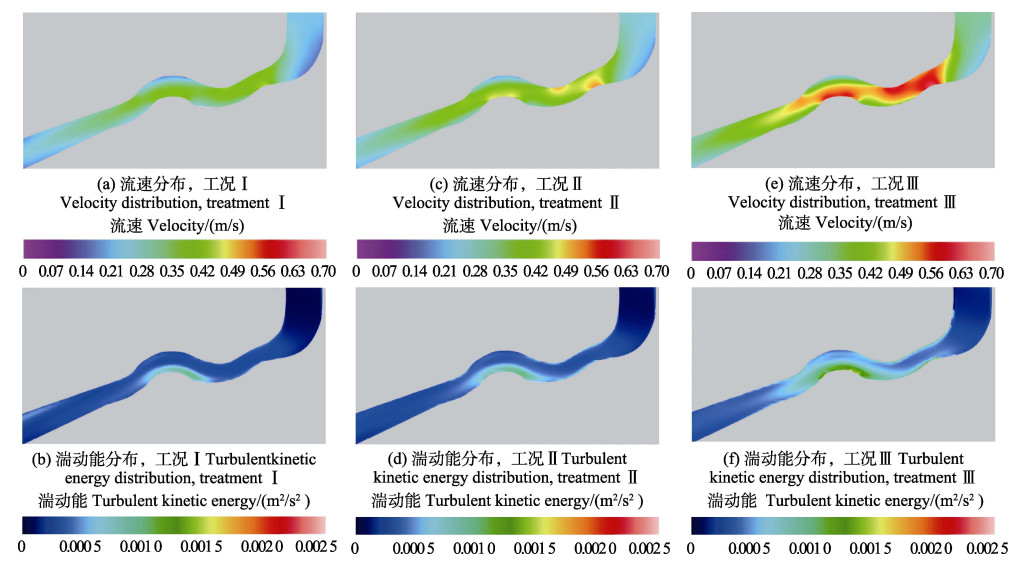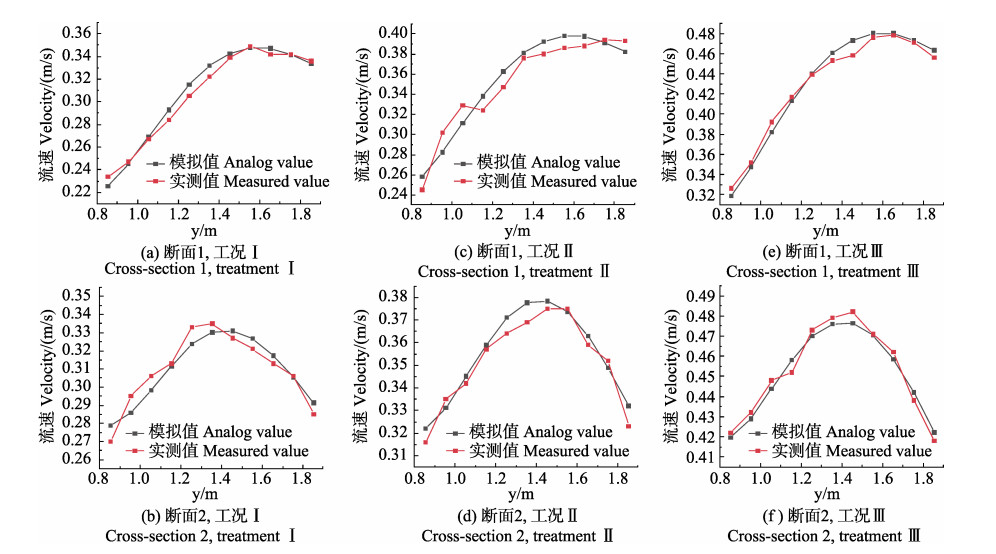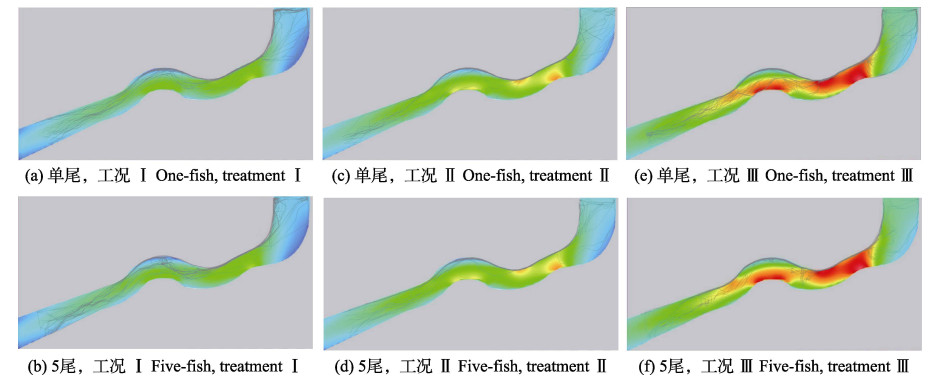2. 河海大学水利水电学院 江苏 南京 210098
2. College of Water Conservancy and Hydropower Engineering, Hohai University, Nanjing 210098, China
水利工程在保障能源安全、优化能源结构和支持欠发达地区社会经济发展等方面贡献突出,然而其所带来的生态环境问题愈发引人担忧(陈求稳等, 2020)。大坝的建成阻滞了河道中的能量交换和物质循环,破坏了河流的物理连续性和生态连通性(望磊等, 2019; 李新丹等, 2022)。同时,电站运行调度也影响了河流生态系统的功能(林俊强等, 2022; 陈求稳等, 2020)。随着河流连通性的急剧下降及水生生物栖息地的逐步退化,河流中洄游鱼类的种群存续正面临着严峻考验。为应对水电开发对鱼类生存带来的冲击,保持鱼类丰度和多样性,我国针对主要流域的目标洄游鱼类规划并实施了一系列鱼类保护措施,集中体现在过鱼设施的修建与增殖放流、生态流量目标的制定与调度保障、鱼类栖息生境的修复与生境替代等3个方面(郑姁姁等, 2020; Stone, 2016)。此外,我国自2020年1月1日起全面实施“长江十年禁渔”保护战略(姜涛等, 2022)。鱼类保护体系的建立对促进水利工程上下游鱼类基因交流、维持鱼类种群结构和保护鱼类遗传多样性至关重要(陈凯麒等, 2012; 王琲等, 2013; 吴晓春等, 2014)。
目前,国内外学者围绕鱼类保护措施已开展大量研究,特别是针对过鱼设施水力学以及鱼类运动特性与水力要素的响应关系已广泛开展室内外实验。为给鱼道设计提供基础生物学数据支持,国内外学者广泛测试了目标洄游鱼类的游泳能力,并以此为基础开展了一系列鱼类克流上溯行为特征研究。研究显示,齐口裂腹鱼(Schizothorax prenanti)在竖缝式鱼道中上溯时会避开高流速和高湍动区(张浩男等, 2020),而草鱼(Ctenopharyngodon idella)和鳙(Aristichthys nobilis)倾向于沿高流速区快速完成上溯(谭均军等, 2017)。金志军等(2018)通过在类竖缝式鱼道中开展自主游泳能力测试实验量化鱼类上溯行为,发现鱼类上溯效率与其上溯路径密切相关,鱼类沿高能耗路径上溯时往往会带来更多的生理负担(Quintella et al, 2004)。值得注意的是,自然界鱼类大多以群体的方式活动,而当前过鱼设施相关研究大多以单尾鱼作为研究对象,所以很有必要关注鱼类成群游动时的行为特征。
鱼类集群行为被认为在应对潜在危险、提高自身适应性、扩大种群弹性及增强种群可持久性等方面发挥着重要作用,例如,提高觅食效率、降低被捕食率和节约能耗成本等(Pavlov et al, 2000; Marras et al, 2013; 覃英莲等, 2017)。此外,鱼群的集体记忆可以提高鱼类的精准洄游能力(Berdahl et al, 2016),个体间的有效互动也会决定鱼类的生殖洄游时间(Berdahl et al, 2017)。Okasaki等(2020)进一步揭示了鱼类集群行为在减轻人为障碍(闸、坝等)对鱼类洄游影响方面的潜在作用,强调了将种群密度和社交互动等生物因素纳入洄游模型的重要性。然而,目前仍缺乏细观尺度的研究来量化集群行为对鱼类克流过障能力的具体影响。
草鱼和鲢(Hypophthalmichthys molitrix)是我国重要的淡水经济鱼类,也是典型的河湖半洄游鱼类(龚丽等, 2015; 李会锋等, 2016),从鱼类保育、经济价值以及可获取性等方面综合考虑,二者可作为本研究的理想研究对象。本研究将影响鱼类洄游过坝的内外部驱动因子相结合,分析不同水流条件下集群行为对鱼类克流上溯特征的影响,以期为鱼类保护措施的设计和鱼类洄游模型的构建提供参考。
1 材料与方法 1.1 实验动物实验所用草鱼和鲢幼鱼来源于同一亲本,购于湖北省宜都市鱼种场,并通过塑料充氧袋运至三峡大学生态水利学实验室。草鱼幼鱼平均体长为(12.5±0.9) cm,平均体重为(33.3±4.2) g,鲢幼鱼平均体长为(12.6± 1.4) cm,平均体重为(34.9±8.5) g。实验鱼在浅蓝色圆形玻璃纤维水缸内(直径300 cm、高80 cm)暂养7 d,暂养期间,以商用颗粒饲料(重庆通威饲料有限公司)投喂,每天投食2次(07:30和18:30),投食量占鱼体重的2%~5%,每次投食1 h后用虹吸管吸出残饵和粪便。暂养期间,控制水深为30 cm,水温为(22±1)℃,溶氧量 > 8 mg/L,pH=7.1~7.3,每天换水约1/3左右。待其状况稳定、正常进食和游动后开始实验(王琼等, 2018),实验时,随机选取健康且体长均等的草鱼和鲢幼鱼作为实验对象。实验结束后,将实验鱼放入其他暂养水池。为保持实验样本的独立性,实验鱼不再重复使用。
1.2 实验装置本实验装置为三峡大学生态水利学实验室自建开放式循环水槽,如图 1所示。最大槽宽为2 m,曲线段最小曲率圆的半径为0.13 m,最大曲率圆的半径为0.37 m,坡度为3‰,装置由上游整流区、中间测试区、下游适应区、水循环系统和监控系统等五部分组成。其中,测试区域自上游至下游依次为上游曲线渐变段、中游曲线段和下游直线渐变段,可为鱼类提供典型的低湍动非均匀流场测试环境。实验用水为三峡大学水工厅小型水库循环水,水温与暂养水温基本一致。在架设监控系统前将整个实验水槽划分为6个矩形区块并布设参考线,然后在每个矩形区块正上方架设一台红外网络摄像仪(DS-2CD3T46DWD-I3海康威视),最后,利用Surfer软件将6个摄像头的视频画面进行拼接以组成监控系统,可实现对鱼类上溯行为的可视化,并在如图 1所示的位置构建平面坐标系,以方便获取整个测试区原始的鱼类行为学数据,以备后续分析。

|
图 1 实验装置示意图 Fig.1 Side view of test flume |
本研究选择草鱼幼鱼和鲢幼鱼作为实验对象,鲤科鱼类的感应流速介于0.07~0.23 m/s之间(蔡露等, 2018),草鱼幼鱼和鲢幼鱼的临界游泳速度分别为0.97和0.79 m/s (龚丽等, 2015; 李会锋等, 2016),本研究将比实验鱼感应流速略大的0.25 m/s确定为设计低流速,将比实验鱼临界游泳速度小的0.7 m/s确定为设计高流速,然后,在设计流速范围内设置3个流速梯度水平,分别为工况Ⅰ(0.25~0.50 m/s),工况Ⅱ(0.3~0.6 m/s)和工况Ⅲ(0.35~0.70 m/s)。在3种流速工况下分别设置5尾处理组与单尾处理组,其中,5尾处理组每个处理重复10次,单尾处理组每个处理重复50次(表 1)。为避免光照条件和昼夜节律对实验结果造成影响,本实验测定均在白天进行(08:00~ 18:00),实验区平均照度水平为(1 000±200) lx。为保证实验鱼在每次重复上溯前的应激水平一致,需确定实验鱼从终点逃逸至起点后所需要的恢复时间。针对此问题,本研究设计预实验来探究不同恢复时间(10、30和60 s)对“捕食者”追赶组实验鱼上溯效率的影响,明确当实验鱼从终点逃逸至起点恢复30 s后再打开下游拦网使其自主上溯时,其上溯用时与对照组的上溯用时无显著性差异。此外,预实验结果显示,实验鱼的上溯平均用时为(101.6±32.3) s,最长耗时为256.0 s,均小于5 min,故本研究做以下设定,若实验鱼在5 min内上溯至上游拦网0.5 m范围内,则记1次成功。
|
|
表 1 实验处理 Tab.1 Experimental treatments |
正式实验前,均匀调整测试区流速至实验目标流速工况,然后从暂养池中随机捞取健康活泼的实验鱼并将其转运至适应区,适应30 min。适应结束后,缓慢打开下游拦网,同时开启摄像仪连续记录实验区鱼类行为。若实验鱼在规定时间内上溯成功,则用抄网模拟捕食者袭击(Brown et al, 2007),将其追赶至水槽起点,关闭适应区拦网30 s后再打开拦网使其重新自主上溯,直至其上溯失败。实验结束后,关闭摄像仪并测量每条实验鱼的体长和体重。由于本实验着重研究鱼类在二维空间的克流行为特征,故设置实验水深为0.18~0.20 m,以排除鱼类垂向运动对实验结果的影响。
1.4 水力计算本实验测试水槽模型为典型的自由液面模型,利用Tur-VOF方法追踪自由液面,基于有限差分法将模拟控制方程离散为代数方程组进行求解计算,对计算区域采用六面体单元进行网格划分,网格总数100万个。本研究的物理模型为水槽测试区域,自上游至下游依次包括上游曲线渐变段、中游曲线段和下游直线渐变段,水槽坡度仅为3‰。鱼道进口边界条件设置为流量进口,出口边界条件设置为压力出口,其余为固体边界,自由液面条件设定为压力边界条件P,其压强为大气压强,流体分数F=0。本研究的模型属于不可压缩的湍流流动,故采用RNG k-ε模型计算(陈磊等, 2021),主要控制方程如下:
连续性方程:
| $ \frac{{\partial \rho }}{{\partial t}} + \frac{{\partial \rho {u_i}}}{{\partial {x_i}}} = 0 $ | (1) |
动量方程:
| $ \begin{gathered} \frac{{\partial \rho {u_i}}}{{\partial t}} + \frac{\partial }{{\partial {x_i}}}(\rho {u_i}{u_j}) = \hfill \\ \;\;\;\;\;\;\;\; - \frac{{\partial p}}{{\partial {x_i}}} + \frac{\partial }{{\partial {x_j}}}\left[ {(\mu + {\mu _t})\left({\frac{{\partial {u_i}}}{{\partial {u_j}}} + \frac{{\partial {u_j}}}{{\partial {u_i}}}} \right)} \right] \hfill \\ \end{gathered} $ | (2) |
k方程:
| $ \frac{{\partial (\rho k)}}{{\partial t}} + \frac{{\partial (\rho {u_i}k)}}{{\partial {x_i}}} = \frac{\partial }{{\partial {x_i}}}\left[ {\left({\mu + \frac{{{\mu _t}}}{{{\sigma _k}}}} \right)\frac{{\partial k}}{{\partial {x_i}}}} \right] + {G_k} - \rho \varepsilon $ | (3) |
ε方程:
| $ \begin{gathered} \frac{{\partial (\rho \varepsilon)}}{{\partial t}} + \frac{{\partial (\rho {u_i}\varepsilon)}}{{\partial {x_i}}} = \hfill \\ \;\;\;\;\;\;\;\;\;\;\frac{\partial }{{\partial {x_i}}}\left[ {\left({\mu + \frac{{{\mu _t}}}{{{\sigma _\varepsilon }}}} \right)\frac{{\partial \varepsilon }}{{\partial {x_i}}}} \right] + \frac{{C_{1\varepsilon }^*\varepsilon }}{k}{G_k} - C_{2\varepsilon }^*\rho \frac{{{\varepsilon ^2}}}{k} \hfill \\ \end{gathered} $ | (4) |
式中,t为时间(s);ui、uj分别为xi、xj方向的时均流速(m/s);ρ为体积分数平均密度(kg/m3);μ为流体黏滞系数(N⋅s/m2);μt为湍动黏度(N⋅s/m2),μt = ρCμk2/ε,Cμ=0.0845;P为修正压力(pa);k为湍动能(m2/s2);σk=1.39;ε为湍动耗散率(kg⋅m2/s3);σε=1.39;Gk为平均速度梯度引起的湍动能产生项,
采用Tru-VOF方法追踪自由水面流动,采用流体体积分数αω描述水和气自由表面的各种变化,通过求解水气两相体积分数连续方程来确定自由水面的位置。其方程为:
| $ \frac{{\partial {\alpha _\omega }}}{{\partial t}} + {u_i}\frac{{\partial {\alpha _\omega }}}{{\partial {x_i}}} = 0 $ | (5) |
式中,ui为各向的速度分量;αω为水的体积分数。当αω=0时,计算单元内全为气相;当αω=1时,计算单元内全为水相;当0 < αω < 1时,计算单元内同时包含水相和气相。
1.5 数据处理本研究旨在揭示不同水流条件下集群行为对鱼类过障克流能力的影响。基于此,构建新型指标体系,采用无量纲化的持久上溯能力d表示实验鱼的克流能力,并采用首次上溯时长Tfirst和首次上溯累积耗能E分别表示鱼类的上溯速度和上溯能耗成本,同时考察鱼类的上溯轨迹,获取轨迹分布及轨迹点上的水力参数分布。
持久上溯能力D为:
| $ D = i - \frac{{{T_i}}}{{300}} $ | (6) |
无量纲化持久上溯能力为:
| $ d = \frac{{{D_k} - {D_{min}}}}{{{D_{max}} - {D_{min}}}} $ | (7) |
式中,i表示实验鱼在重复上溯过程中的成功次数,Ti在单尾鱼处理组表示实验鱼第i次上溯所需时长,在群鱼处理组表示实验鱼群第i次上溯平均所需时长。k表示工况类别,Dmin表示实验鱼在所有工况下的最小持久上溯能力,Dmax表示实验鱼在所有工况下的最大持久上溯能力;d的范围介于0~1,d值越接近1,表示实验鱼在第k种工况下的持久上溯能力越强。
鱼体的游泳阻力f为(Khan et al, 2006; 吴震等, 2019; Tan et al, 2022):
| $ f = 0.5{C_d}\rho {A_s}{({U_w} - {U_f})^2} $ | (8) |
式中,Cd为阻力系数,计算公式为(Pettersson et al, 1999):Cd≈1.2Cf,Cf=0.074Ref−0.2,式中,Ref=ρuf Lf/μ为鱼体雷洛数(Webb, 1971);ρ为水体密度;
绝对上溯轨迹长度S为:
| $ S = |{U_w} - {U_f}|t $ | (9) |
故上溯累积耗能E为:
| $ E = \int_0^S {|f|{\text{d}}S} $ | (10) |
本研究采用多个独立样本非参数检验(Mann Whitney U test和Kruskal Wallis H test),检验实验鱼在不同工况下的统计指标差异是否显著,检验用SPSS 25.0软件进行,统计值用平均值±标准差(Mean± SD)表示,P < 0.05表示有显著性差异。计算累积耗能时,采用MATLAB2020b自编程序提取鱼类上溯轨迹点处的流场信息。
2 结果与分析 2.1 流场模拟结果分析数值模拟计算结果(流速与湍动能的空间分布)如图 2所示。上游曲线渐变段的流速、湍动能整体分布较均匀,只在与中游曲线段衔接处才出现较大的流速梯度;中游曲线段的流速梯度较大,且最高流速发生在边界曲率最大处附近,其流场可大致划分为凸岸高流速主流区和凹岸低流速边界区,主流区流线呈微弯“S”型;下游直线渐变段的流速梯度较小,其横断面流速分布呈“中间高、两侧低”的趋势。测试水槽边壁光滑无棱角,湍动能在3种流速工况下均未超过0.002 5 m2/s2,较高的湍动能主要分布在水槽中游曲线段左侧凸岸处。随着流速工况的增大,高流速区和高湍动区的范围呈递增趋势,而低流速区和低湍动区相反。

|
图 2 不同流速工况下数模结果图 Fig.2 CFD outcome in different velocity treatments |
本研究在选取的2个断面(断面1,x=5.3 m;断面2,x=4.3 m)上每隔0.1 m布设一个测点,以验证数值模拟结果的准确性,验证断面1、2的布置情况如图 1所示。因实验水槽整体湍动能较低,故只对2个断面的实测流速和模拟流速进行对比分析。根据3种流速工况下的对比结果可以看出,断面1的流速均呈现左岸偏小、右岸偏大(主流贴壁)的分布特征,断面2的流速均呈现两岸偏小、中间偏大的分布特征。2个断面的流速实测值和模拟值整体吻合良好(图 3),其结果可用于进一步的研究分析。

|
图 3 不同流速工况下数模结果的准确性验证 Fig.3 Accuracy verification of CFD outcome in different velocity treatments 横坐标标题y表示1.1构建的二维平面坐标系的纵坐标轴 X-axis title y represents the vertical axis of the two-dimensional plane coordinate system constructed by 1.1 |
本研究统计了鱼类在不同流速工况下的无量纲化持久上溯能力,以探讨流速对鱼类持久上溯能力的影响。从图 4可以看出,草鱼幼鱼的无量纲化持久上溯能力整体小于鲢幼鱼。单尾草鱼幼鱼的无量纲化持久上溯能力随流速增大呈先减弱后增强的趋势,且在0.30~0.60 m/s流速工况下显著低于0.25~0.50 m/s和0.35~0.70 m/s流速工况(P < 0.001, P=0.013)。5尾草鱼幼鱼的无量纲化持久上溯能力随流速的增大呈递减趋势,且在0.25~0.50 m/s流速工况下显著高于0.30~ 0.60 m/s和0.35~0.70 m/s流速工况(P=0.043, P < 0.001) (图 4a)。单尾鲢幼鱼的无量纲化持久上溯能力随着流速的增大呈递减趋势,且在0.25~0.50 m/s流速工况下显著高于0.35~0.70 m/s流速工况(P=0.010)。5尾鲢幼鱼的无量纲化持久上溯能力随流速的增大呈先减弱后增强的趋势,且在0.30~0.60 m/s流速工况下显著低于0.35~0.70 m/s流速工况(P < 0.001)(图 4b)。

|
图 4 草鱼幼鱼、鲢幼鱼在不同工况下的无量纲化持久上溯能力 Fig.4 The nondimensionalized ascending sustainability of juvenile grass carp and juvenile silver carp in different treatments 不同大写字母表示单尾鱼流速间的差异;不同小写字母表示5尾鱼流速间差异;*表示同一流速条件下不同群体大小实验鱼的差异;图中的显著性水平均为0.05。─表示中位数;▪表示均值;◦表示异常值;上须线表示1.5倍的上四分位数,下须线表示1.5倍的下四分位数。下同 Different upper cases indicate the significant inter-velocity differences in one fish treatment; different lower cases indicate significant inter-velocity differences in five fish treatments; significance level is 0.05. * indicates significant difference among different group sizes with the same velocity. ─indicates median; ▪ indicates mean value; ◦ indicates outlier; upper whisker line indicates 1.5 times upper quartile, lower whisker line indicates lower quartile of 1.5 times. The same below. |
通过对比不同群体大小的无量纲化持久上溯能力可以发现,对草鱼而言,在0.30~0.60 m/s流速工况时,单尾组显著低于5尾组(P=0.030),在0.35~0.70 m/s流速工况时,单尾组显著高于5尾组(P=0.048),而在0.25~0.50 m/s流速工况下,2组无量纲化持久上溯能力无显著差异(P=0.121)(图 4a)。对鲢而言,在0.25~ 0.5 m/s和0.35~0.70 m/s流速工况下,单尾组均显著低于5尾组(P=0.004, P < 0.001),而在0.30~0.60 m/s流速工况下,2组无量纲化持久上溯能力无显著差异(P=0. 217)(图 4b)。
2.2.2 不同工况下的首次上溯时长从图 5可以看出,草鱼幼鱼的首次上溯时长在总体水平上相对鲢幼鱼较小。通过对比分析鱼类在不同流速工况下的结果可以发现,草鱼幼鱼的首次上溯时长随流速增大呈递增趋势,且单尾组在0.25~0.50 m/s流速工况下的时长显著低于0.30~0.60 m/s、0.35~0.70 m/s流速工况(P=0.005, P=0.001),5尾组在0.35~0.70 m/s流速工况下的时长显著高于0.25~0.50 m/s、0.30~0.60 m/s流速工况(P=0.001, P=0.005)(图 5a)。单尾鲢幼鱼的首次上溯时长随流速增大呈递增趋势,且在0.35~0.70 m/s流速工况下显著高于0.25~0.50 m/s、0.30~0.60 m/s流速工况(P=0.003, P=0.028)。5尾鲢幼鱼的首次上溯时长随流速增大呈先增加后减少的趋势,且在0.35~0.70 m/s流速工况下显著低于0.25~0.50 m/s、0.30~0.60 m/s流速工况(P < 0.001, P < 0.001)(图 5b)。

|
图 5 草鱼幼鱼、鲢幼鱼在不同工况下的首次上溯时长 Fig.5 The endurance of the first attempt of juvenile grass carp and juvenile silver carp in different treatments |
通过对比不同群体大小的首次上溯时长可知,就草鱼而言,在0.25~0.50 m/s、0.35~0.70 m/s流速工况下,单尾组均显著低于5尾组(P < 0.001, P=0.005),而在0.30~0.60 m/s流速工况下,2组首次上溯时长无显著差异(P=0.445)(图 5a)。就鲢而言,在0.25~0.50 m/s、0.30~0.60 m/s流速工况下,单尾组均显著低于5尾组(P < 0.001,P=0.005),而在0.35~0.70 m/s流速工况下,单尾组显著高于5尾组(P < 0.001)(图 5b)。
2.3 集群行为对鱼类上溯路径的影响实验观察发现,2种鱼在上溯过程中均表现出典型的集群行为。整体而言,草鱼幼鱼的上溯路径较鲢幼鱼更为单一。观察草鱼幼鱼在不同流速工况下的上溯轨迹(图 6)可以发现,在低流速条件下,草鱼倾向于沿多样化的路径快速完成上溯,随着流速的增大,单尾草鱼幼鱼的上溯轨迹分布呈先集中后分散的趋势,且其经过水槽曲线段时仅有少量实验鱼会积极尝试其他上溯路径。此外,在0.35~0.70 m/s流速工况下,相对于5尾组而言,更多的单尾实验鱼在经过水力障碍区时会积极尝试以找到流速较低的路径上溯,这可能是高流速工况下单尾组的持久上溯能力显著高于5尾组的原因。

|
图 6 草鱼幼鱼在不同工况下的首次上溯轨迹 Fig.6 The trajectory of first attempt of juvenile grass carp in different treatments |
观察鲢幼鱼在不同流速工况下的上溯轨迹(图 7)可以发现,随流速工况的增大,越来越多的鲢趋向于沿右岸边壁上溯,这可能是一种节能策略。此外,单尾鲢幼鱼的上溯轨迹分布趋于分散,5尾鲢的上溯轨迹趋于集中,说明鲢幼鱼个体间的视觉引导作用可以帮助其在不利的水流环境中找到合适的上溯路径。

|
图 7 鲢幼鱼在不同工况下的首次上溯轨迹 Fig.7 The trajectory of first attempt of juvenile silver carp in different treatments |
鱼类沿河道长距洄游存在明显的节能策略(Hinch et al, 2000)。本研究中,实验鱼在不同工况下沿水槽短距上溯时同样会表现出不同的行为策略。鱼类上溯累积耗能是指鱼类整个上溯过程克服阻力做功之和。通过提取上溯轨迹点以获取实际水流速度(Uw)和鱼类的绝对游泳速度(Uf),可有效地将水动力要素与鱼类游泳速度、运动轨迹及克服阻力相结合,以反映实验鱼在不同工况下沿不同路径上溯时的能耗状态。整体而言,草鱼幼鱼的首次上溯累积耗能较鲢幼鱼更大(图 8)。

|
图 8 草鱼幼鱼、鲢幼鱼在不同流速工况下的首次上溯累积耗能 Fig.8 The accumulated energy consumption of the first attempt of juvenile grass carp and juvenile silver carp in different velocity treatments |
通过对比不同流速工况下的首次上溯累积耗能可以发现,草鱼幼鱼的上溯能耗随流速的增大均呈递增趋势,且在0.35~0.70 m/s流速工况下显著高于0.25~0.50 m/s和0.30~0.60 m/s流速工况(单尾组:P=0.035,P=0.024;5尾组:P < 0.001,P < 0.001)(图 8a)。鲢幼鱼的上溯能耗随流速的增大同样呈递增趋势,且在0.35~0.70 m/s流速工况下显著高于0.25~0.50 m/s和0.30~0.60 m/s流速工况(单尾组:P < 0.001,P=0.001;5尾组:P < 0.001,P < 0.001)(图 8b)。
比较同一流速工况下不同群体大小间的首次上溯累积耗能可得,在0.25~0.50 m/s流速工况下,草鱼幼鱼5尾组耗能显著低于单尾组(P < 0.001),而在0.30~ 0.60 m/s和0.35~0.70 m/s流速工况下,2组的耗能无显著差异(P=0.122, P=0.990)(图 8a)。同样地,在0.30~0.60 m/s和0.35~0.70 m/s流速工况下,鲢幼鱼单尾组和5尾组的累积耗能也无显著差异(P=0.087, P=0.260)。与草鱼幼鱼不同的是,在0.25~0.50 m/s流速工况下,鲢幼鱼5尾组的首次上溯累积耗能显著高于单尾组(P=0.050)(图 8b)。
3 讨论 3.1 鱼类上溯行为模式在众多环境要素当中,流速和流态被普遍认为是影响鱼类上溯洄游的关键因子(Castro-Santos et al, 2010)。本研究评估和量化了草鱼幼鱼和鲢幼鱼在应对3种不同水流工况时的行为响应。值得注意的是,由于本实验测试区流场湍动能背景值偏低,鱼类在上溯过程中受湍动能影响较小,其上溯行为主要受流速变化影响。有研究指出,鱼类在高流速条件下表现出更为复杂的上溯行为特征,例如,在行进过程中停顿、休憩、折返等(吴震等, 2019),这可能会增加鱼类的上溯时长。根据实验结果,草鱼幼鱼和单尾鲢幼鱼的首次上溯时长随流速增大均呈递增趋势。然而,5尾鲢幼鱼在0.35~0.70 m/s流速工况下的首次上溯时长显著小于其他2个流速工况,究其原因,可能是高流速和集群行为激发了鲢幼鱼的上溯积极性。此外,高流速极可能会影响鱼类的游泳稳定性,并带来更多的能量消耗(Webb, 2004; 吴震等, 2019)。本研究结果也证明了这一点,草鱼幼鱼和鲢幼鱼的首次上溯累积耗能随流速增大均呈递增趋势,即鱼类的累积上溯耗能与其所处流场的流速呈正相关关系。
水流对水生生物的影响呈多样化趋势(齐亮等, 2012),不同生态习性的鱼类往往会表现出不同的上溯行为策略。本研究3种流速工况下实验鱼上溯轨迹点所对应流速分布呈正态分布趋势(正态性检验结果P > 0.05)。草鱼幼鱼轨迹点对应流速分布的高斯方程为:
| $ y = 0.161 \times \exp [ - 0.5{(x - 0.348)^2}/{0.149^2}] $ | (11) |
其中,速度均值μ = 0.348 m/s,方差σ = 0.149,轨迹点处对应的流速有90%小于0.484 m/s。
鲢幼鱼轨迹点处对应流速的高斯方程为:
| $ y = 0.189 \times \exp [ - 0.5{(x - 0.349)^2}/{0.109^2}] $ | (12) |
其中,速度均值μ = 0.349 m/s,方差σ = 0.109,轨迹点处对应的流速有90%小于0.459 m/s。通过对比分析2种鱼上溯轨迹点的流速分布可知,鲢上溯过程中所选择的流速范围较草鱼更为集中(如图 9)。结合上述鱼类上溯行为特征和上溯轨迹还可以发现,不同的种群在受到相同的水流刺激时会有不同的趋流表现,鲢幼鱼的上溯用时更长,上溯累积耗能更大,上溯轨迹也更具多样性,这说明鲢相对于草鱼会花费更长的时间搜索流速适宜的上溯路径,但长时间的搜寻前进同时也增加了鲢的上溯累积耗能。

|
图 9 草鱼幼鱼、鲢幼鱼上溯轨迹点对应流速 Fig.9 Water velocities at the trajectories of juvenile grass carp and juvenile silver carp |
集群行为是鱼类在长期自然选择的过程中逐渐进化形成的一种行为策略,在鱼类逆流上溯过程中发挥着重要作用(Delcourt et al, 2012)。本研究发现,集群对鱼类上溯的影响主要体现在运动能耗、视觉反应和克流能力等3个方面。
有学者研究发现,鱼类会利用邻近个体运动产生的涡旋来节省肌肉能耗(周应祺等, 2013; Hemelrijk et al, 2015)。本研究上溯累积能耗结果表明,草鱼幼鱼鱼群在3种流速工况下均表现出节能策略,但仅在低流速工况下具有显著性差异。与草鱼不同的是,鲢的集群行为反而会对其游泳耗能产生负面影响,且在低流速工况下具有显著性差异,这说明集群对鱼类运动能耗方面的影响不仅与其生态习性有关,而且与其运动过程所经历的水流环境有关。
鱼类会将邻近个体作为参考点,并对其运动表现出视觉跟随反应,但考虑到鱼群的自组织现象(Pavlov et al, 2000)、个体的异质性及水流环境的复杂性,当上溯积极性较弱的个体处于鱼群的领导地位时,个体间的牵制作用将会凸显出来,这可能是集群行为导致鱼类上溯时长普遍增大的原因。此外,草鱼幼鱼鱼群在0.35~0.70 m/s流速工况下的持久上溯能力和上溯效率较单尾鱼均显著降低,这说明鱼类长时间的高耗能顶流行为可能会影响其上溯积极性。
关于集群对鱼类克流能力方面的影响,本研究结果显示,在0.30~0.60 m/s和0.25~0.50 m/s流速工况下,草鱼和鲢幼鱼的集群行为会普遍提高其持久上溯能力,且在部分工况具有显著性差异,可能的原因是鱼群内个体间积极的互动和有效的信息传递可有效对抗外界环境的干扰(De Bie et al, 2020)。此外,鲢幼鱼鱼群在0.35~0.70 m/s流速工况下的持久上溯能力和上溯效率均显著高于单尾鱼。从行为上看,鲢幼鱼鱼群在高流速胁迫下被迫采用的爆发-滑行游泳模式显著提高了它的克流能力。
总而言之,集群行为在洄游鱼类逆流上溯过程中发挥着不可替代的作用,其对鱼类运动特性和克流能力的影响因流速而异,且具有种间差异,所得结果可为过鱼设施的运行提供具体建议。例如,当鲢在鱼道内上溯时,可适当在鱼道池室内补光以促进集群(Miyazaki et al, 2000),进而提高其克流能力;而当草鱼通过鱼道时,可在休息池室内适当补光以促进集群,避免其因持久上溯能力不足而出现折返行为(Lin et al, 2022)。考虑到自然水域的水动力环境和鱼群的群体大小是极其复杂多变的,后续将针对鱼群在不同水流环境中的集群行为特征展开研究,以期为护鱼工程的规划实施提供更多的基础数据。
4 结论本研究统计不同工况下实验鱼的无量纲化持久上溯能力、首次上溯时长、首次上溯累积耗能以及鱼类上溯轨迹点分布,在不同水流条件下探讨了集群对鱼类上溯行为特征和克流过障能力的影响。主要结论如下:
(1) 草鱼幼鱼的上溯轨迹较鲢幼鱼更为单一,鲢比草鱼更容易找到适宜的上溯路径。
(2) 鱼类的上溯时长和累积耗能随流速增大一般呈递增趋势。然而,由于鲢幼鱼鱼群在高流速工况下被迫采用的爆发–滑行游泳模式,显著提高了上溯效率,故鲢幼鱼鱼群的上溯时长随流速增大呈先增加后减少的趋势。
(3) 集群行为对鱼类上溯行为的影响与鱼个体的持久上溯能力有关。当个体的持久上溯能力处于较低水平时,集群会导致鱼类持久上溯能力显著增大,但对其上溯效率的影响无明显规律;而当个体的持久上溯能力处于较高水平时,集群会导致鱼类上溯效率显著降低,但对其持久上溯能力的影响无明显规律。
(4) 在鱼类自主上溯过程中,集群行为既可能增加也可能减少其游泳能耗,这与集群鱼类本身生态习性及上溯所经流场特性有关。
BERDAHL A, WESTLEY P A H, LEVIN S A, et al. A collective navigation hypothesis for homeward migration in anadromous salmonids. Fish and Fisheries, 2016, 17(2): 525-542 DOI:10.1111/faf.12084 |
BERDAHL A, WESTLEY P A H, QUINN T P. Social interactions shape the timing of spawning migrations in an anadromous fish. Animal Behaviour, 2017, 126: 221-229 DOI:10.1016/j.anbehav.2017.01.020 |
BROWN C, BURGESS F, BRAITHWAITE V A. Heritable and experiential effects on boldness in a tropical poeciliid. Behavioral Ecology and Sociobiology, 2007, 62(2): 237-243 DOI:10.1007/s00265-007-0458-3 |
CAI L, WANG W Y, WANG H L, et al. Response of induced flow speed to fish body length and its application in flow design of fish passage facilities. Transactions of the Chinese Society of Agricultural Engineering, 2018, 34(2): 176-181 [蔡露, 王伟营, 王海龙, 等. 鱼感应流速对体长的响应及在过鱼设施流速设计中的应用. 农业工程学报, 2018, 34(2): 176-181] |
CASTRO-SANTOS T, LETCHER B H. Modeling migratory energetics of Connecticut River American shad (Alosa sapidissima): Implications for the conservation of an iteroparous anadromous fish. Canadian Journal of Fisheries and Aquatic Sciences, 2010, 67(5): 806-830 DOI:10.1139/F10-026 |
CHEN K Q, CHANG Z N, CAO X H, et al. Status and prospection of fish pass construction in China. Journal of Hydraulic Engineering, 2012, 43(2): 182-188 [陈凯麒, 常仲农, 曹晓红, 等. 我国鱼道的建设现状与展望. 水利学报, 2012, 43(2): 182-188] |
CHEN L, TAN J J, SHI X T, et al. Numerical simulation of hydraulic characteristics of combined baffle type fishway. Journal of Yangtze River Scientific Research Institute, 2021, 38(9): 86-91 [陈磊, 谭均军, 石小涛, 等. 组合隔板式鱼道水力特性数值模拟研究. 长江科学院院报, 2021, 38(9): 86-91] |
CHEN Q W, ZHANG J Y, MO K L, et al. Effects of hydropower development on aquatic eco-environment and adaptive managements. Advances in Water Science, 2020, 31(5): 793-810 [陈求稳, 张建云, 莫康乐, 等. 水电工程水生态环境效应评价方法与调控措施. 水科学进展, 2020, 31(5): 793-810] |
DE BIE J, MANES C, KEMP P S. Collective behaviour of fish in the presence and absence of flow. Animal Behaviour, 2020, 167: 151-159 DOI:10.1016/j.anbehav.2020.07.003 |
DELCOURT J, PONCIN P. Shoals and schools: Back to the heuristic definitions and quantitative references. Reviews in Fish Biology and Fisheries, 2012, 22(3): 595-619 DOI:10.1007/s11160-012-9260-z |
GONG L, WU Y H, BAI Y B L G, et al. Experimental study on swimming capability and swimming behavior of juvenile grass carp. Journal of China Institute of Water Resources and Hydropower Research, 2015, 13(3): 211-216 [龚丽, 吴一红, 白音包力皋, 等. 草鱼幼鱼游泳能力及游泳行为试验研究. 中国水利水电科学研究院学报, 2015, 13(3): 211-216] |
HEMELRIJK C K, REID D A P, HILDENBRANDT H, et al. The increased efficiency of fish swimming in a school. Fish and Fisheries, 2015, 16(3): 511-521 DOI:10.1111/faf.12072 |
HINCH S G, RAND P S. Optimal swimming speeds and forward-assisted propulsion: Energy-conserving behaviors of upriver-migrating adult salmon. Canadian Journal of Fisheries and Aquatic Sciences, 2000, 57: 2470-2478 DOI:10.1139/f00-238 |
JIANG T, YANG J, XUAN Z Y, et al. Preliminary report on the effects of resource recovery on anadromous Coilia nasus in Poyang Lake under the national 10-year fishing ban. Progress in Fishery Sciences, 2022, 43(1): 24-30 [姜涛, 杨健, 轩中亚, 等. 长江禁渔对鄱阳湖溯河洄游型刀鲚资源恢复效果初报. 渔业科学进展, 2022, 43(1): 24-30] |
JIN Z J, MA W Z, ZHANG Y N, et al. Assessing the swimming ability and performance of Schizothorax oconnori to cross velocity barriers in fishway. Journal of Hydraulic Engineering, 2018, 49(4): 512-522 [金志军, 马卫忠, 张袁宁, 等. 异齿裂腹鱼通过鱼道内流速障碍能力及行为. 水利学报, 2018, 49(4): 512-522] |
KHAN L A. A three-dimensional computational fluid dynamics (CFD) model analysis of free surface hydrodynamics and fish passage energetics in a vertical-slot fishway. North American Journal of Fisheries Management, 2006, 26(2): 255-267 DOI:10.1577/M05-014.1 |
LI H F, CAI D S, YANG P S. Swimming ability and behavior of different sized silver carp. Journal of Hydroecology, 2016, 37(3): 88-92 [李会锋, 蔡德所, 杨培思. 鲢幼鱼游泳能力及游泳行为的试验研究. 水生态学杂志, 2016, 37(3): 88-92] |
LI X D, XIAO X P, ZHOU W G, et al. Swimming capacity of Gymnocypris przewalskii and the efficiency of fish passing the fish ladder. Progress in Fishery Sciences, 2022, 43(2): 44-52 [李新丹, 肖新平, 周卫国, 等. 青海湖裸鲤的游泳能力及鱼梯通过效果. 渔业科学进展, 2022, 43(2): 44-52] |
LIN C Y, DENG Z D, SHI X T, et al. Mutually promoting or constraining? Disentangling the superimposed effect of velocity and illuminance on fish motion in low-velocity flows with a novel metric. Freshwater Biology, 2022, 67(8): 1468-1480 DOI:10.1111/fwb.13954 |
LIN J Q, LI Y K, LIU Y, et al. Recent progress in ecological operation and adaptive management for stimulating fish natural spawning. Journal of Hydraulic Engineering, 2022, 53(4): 483-495 [林俊强, 李游坤, 刘毅, 等. 刺激鱼类自然繁殖的生态调度和适应性管理研究进展. 水利学报, 2022, 53(4): 483-495] |
MARRAS S, DOMENICI P. Schooling fish under attack are not all equal: Some lead, others follow. PLoS One, 2013, 8(6): e65784 DOI:10.1371/journal.pone.0065784 |
MIYAZAKI T, SHIOZAWA S, KOGANE T, et al. Developmental changes of the light intensity threshold for school formation in the striped jack Pseudocaranx dentex. Marine Ecology Progress Series, 2000, 192: 267-275 DOI:10.3354/meps192267 |
OKASAKI C, KEEFER M L, WESTLEY P A H, et al. Collective navigation can facilitate passage through human-made barriers by homeward migrating Pacific salmon. Proceedings of the Royal Society B: Biological Sciences, 2020, 287(1937): 20202137 DOI:10.1098/rspb.2020.2137 |
PAVLOV D S, KASUMYAN A O. Patterns and mechanisms of schooling behavior in fish: A review. Journal of Ichthyology, 2000, 40(Suppl2): S163-S231 |
PETTERSSON L B, BRONMARK C. Energetic consequences of an inducible morphological defense in crucian carp. Oecologia, 1999, 121(1): 12-18 DOI:10.1007/s004420050901 |
QI L, YANG Y, WANG Y, et al. Fish behavior characteristics in response to change of hydrodynamic environment. Journal of Hohai University (Natural Sciences), 2012, 40(4): 438-445 [齐亮, 杨宇, 王悦, 等. 鱼类对水动力环境变化的行为响应特征. 河海大学学报(自然科学版), 2012, 40(4): 438-445 DOI:10.3876/j.issn.1000-1980.2012.04.014] |
QIN Y L, BAI Y, PENG J L, et al. Schooling behavior of juvenile rose bitterling (Rhodeus ocellatus). Journal of Hydroecology, 2017, 38(4): 71-76 [覃英莲, 柏杨, 彭姜岚, 等. 高体鳑鲏幼鱼集群行为研究. 水生态学杂志, 2017, 38(4): 71-76] |
QUINTELLA B R, ANDRADE N O, KOED A, et al. Behavioral patterns of sea lampreysx spawning migration through difficult passage areas, studied by electromyogram telemetry. Journal of Fish Biology, 2004, 65(4): 961-972 DOI:10.1111/j.0022-1112.2004.00497.x |
STONE R. Dam-building threatens Mekong fisheries. Science, 2016, 354(6316): 1084-1085 DOI:10.1126/science.354.6316.1084 |
TAN J J, GAO Z, DAI H C, et al. The correlation analysis between hydraulic characteristics of vertical slot fishway and fish movement characteristics. Journal of Hydraulic Engineering, 2017, 48(8): 924–932, 944 [谭均军, 高柱, 戴会超, 等. 竖缝式鱼道水力特性与鱼类运动特性相关性分析. 水利学报, 2017, 48(8): 924–932, 944] |
TAN J J, LIU Z B, WANG Y, et al. Analysis of movements and behavior of bighead carps (Hypophthalmichthys nobilis) considering fish passage energetics in an experimental vertical slot fishway. Animals, 2022, 12(13): 1725 |
WANG B, YANG W J, CHEN H. Construction and research progress of ecological fish-way of hydraulic structure. Yangtze River, 2013, 44(9): 88-92 [王琲, 杨文俊, 陈辉. 生态水工建筑物——鱼道的建设及研究进展. 人民长江, 2013, 44(9): 88-92] |
WANG L, WANG Y, LIN C Y, et al. Effect of accelerating flow on downstream migration behaviors of juvenile grass carps of different body lengths. Journal of Hydroelectric Engineering, 2019, 38(12): 40-48 [望磊, 王煜, 林晨宇, 等. 加速流对不同体长草鱼幼鱼下行行为的影响. 水力发电学报, 2019, 38(12): 40-48] |
WANG Q, LIN C Y, LUO J, et al. Phototaxis of individual and group Hypophthalmichthys molitrix in flowing and still water. Journal of Hydroecology, 2018, 39(5): 60-66 [王琼, 林晨宇, 罗佳, 等. 流水和静水条件下鲢幼鱼对不同强度光源的趋性研究. 水生态学杂志, 2018, 39(5): 60-66] |
WEBB P W. Response latencies to postural disturbances in three species of teleostean fishes. Journal of Experimental Biology, 2004, 207(6): 955-961 |
WEBB P W. The swimming energetics of trout: I. Thrust and power output at cruising speeds. Journal of Experimental Biology, 1971, 55(2): 489-520 |
WU X C, SHI J Q. Construction and management of fish passage on Shaliu River adjacent to Qinghai Lake based on ecological restoration. Transactions of the Chinese Society of Agricultural Engineering, 2014, 30(22): 130-136 [吴晓春, 史建全. 基于生态修复的青海湖沙柳河鱼道建设与维护. 农业工程学报, 2014, 30(22): 130-136] |
WU Z, YANG Z Y, SHI X T, et al. The reentry behavior and its relationship with hydraulic conditions during upstream migration of Schizothorax oconnori. Chinese Journal of Ecology, 2019, 38(11): 3382-3393 [吴震, 杨忠勇, 石小涛, 等. 异齿裂腹鱼上溯过程中的折返行为及其与水力条件的关系. 生态学杂志, 2019, 38(11): 3382-3393] |
ZHANG H N, LI G N, HAN Y C, et al. Study on migration behaviors of juvenile Schizothorax prenanti in a vertical slot fishway model. Water Resources and Hydropower Engineering, 2020, 51(12): 180-187 [张浩男, 李广宁, 韩延成, 等. 齐口裂腹鱼幼鱼在竖缝式鱼道模型中的上溯行为研究. 水利水电技术, 2020, 51(12): 180-187] |
ZHENG X X, ZHANG Y M, TAO S J, et al. Analysis on the development of fish passing facilities at home and abroad. China Southern Agricultural Machinery, 2020, 51(11): 71-72 [郑姁姁, 张雨玫, 陶思佳, 等. 浅析国内外过鱼设施的发展. 南方农机, 2020, 51(11): 71-72] |
ZHOU Y Q, WANG J, QIAN W G, et al. Review of fish schooling behavior study. Journal of Shanghai Ocean University, 2013, 22(5): 734-743 [周应祺, 王军, 钱卫国, 等. 鱼类集群行为的研究进展. 上海海洋大学学报, 2013, 22(5): 734-743] |



